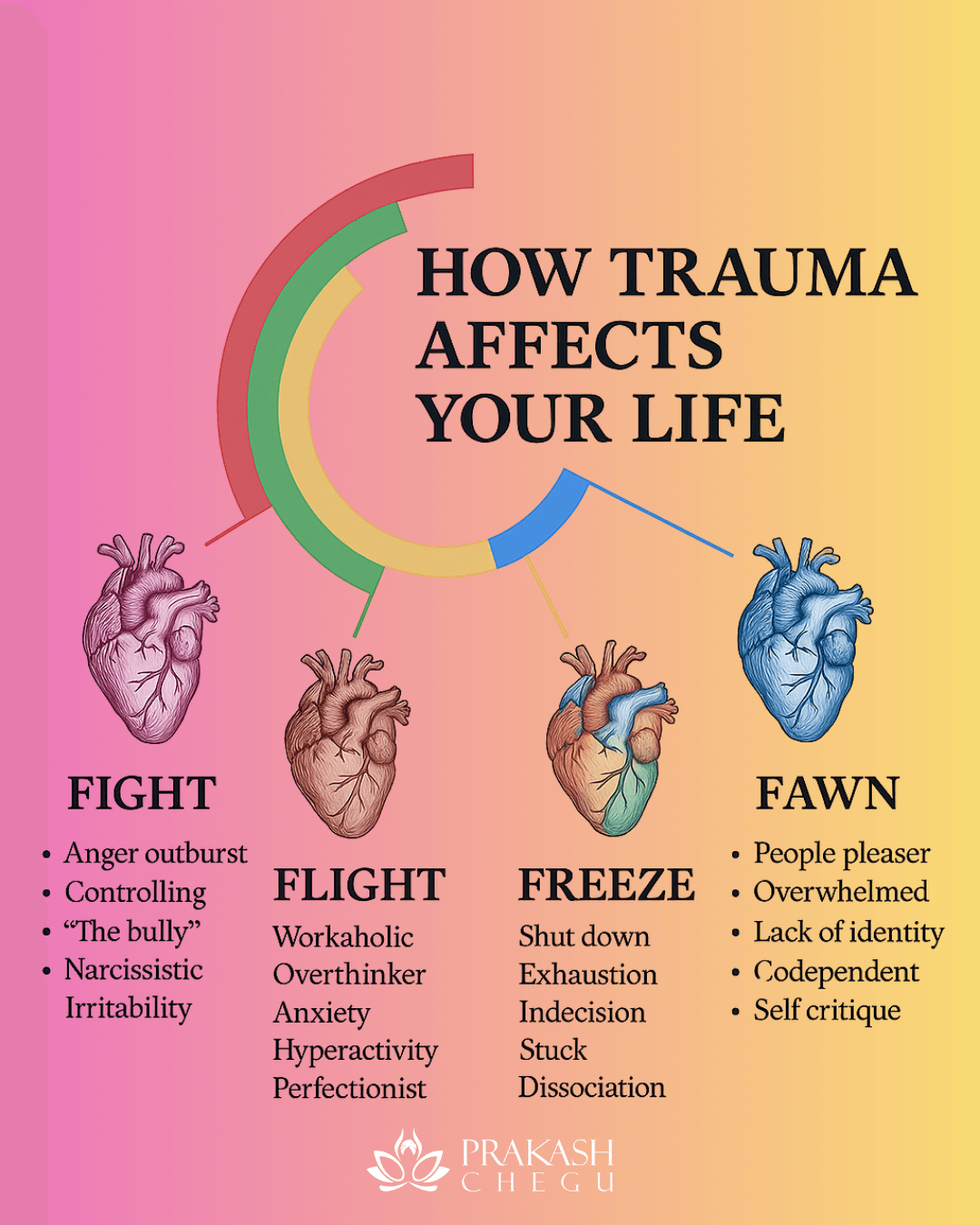When we experience trauma, our nervous system often chooses survival over comfort.
These survival modes are commonly referred to as the Four Trauma Responses: Fight, Flight, Freeze, and Fawn.
While these reactions may have protected us in the past, they can also become ingrained patterns that affect our relationships, health, and self-worth.
These survival modes are commonly referred to as the Four Trauma Responses: Fight, Flight, Freeze, and Fawn.
While these reactions may have protected us in the past, they can also become ingrained patterns that affect our relationships, health, and self-worth.
The good news? Once we recognize our patterns, we can consciously begin to heal and rewire our responses.


1. Fight Response 🟥 (Hyper-aroused & Confrontational)
Signs:
- Anger outbursts
- Controlling behavior
- “The bully” tendency
- Narcissistic traits
- Irritability
Core Pattern:
The nervous system goes on high alert, ready for confrontation to feel safe or in control.
The nervous system goes on high alert, ready for confrontation to feel safe or in control.
Healing Tips:
- Practice slow, deep breathing to bring down the body's stress response.
- Engage in physical release activities—boxing, vigorous yoga, or dance.
- Use journaling to uncover the softer emotions (fear, grief) hiding under anger.
- Meditate on compassion and forgiveness to release defensive energy.
2. Flight Response 🟧 (Hyper-aroused & Avoidant)
Signs:
- Workaholic tendencies
- Overthinking
- Anxiety
- Hyperactivity
- Perfectionism
Core Pattern:
The nervous system stays busy to avoid discomfort, always “on the run” from perceived threats.
The nervous system stays busy to avoid discomfort, always “on the run” from perceived threats.
Healing Tips:
- Ground yourself with nature walks, barefoot grounding, or holding warm tea.
- Schedule rest and play into your daily life, guilt-free.
- Practice mindfulness meditation to quiet the mental overdrive.
- Use gentle Kundalini Yoga kriyas to activate the parasympathetic nervous system.
3. Freeze Response 🟨 (Hypo-aroused & Immobilized)
Signs:
- Emotional shut down
- Chronic exhaustion
- Indecision
- Feeling stuck
- Dissociation
Core Pattern:
The body goes into a numb, still state as protection, making forward action difficult.
The body goes into a numb, still state as protection, making forward action difficult.
Healing Tips:
- Start with micro-movements: gentle stretches, shaking, or tapping.
- Practice breath of fire or other energizing breathwork.
- Set small, achievable goals to rebuild momentum and self-trust.
- Spend time with safe, supportive people to re-engage socially.
4. Fawn Response 🟦 (Appeasing & Self-Sacrificing)
Signs:
- People-pleasing behavior
- Feeling overwhelmed
- Loss of personal identity
- Codependency
- Self-criticism
Core Pattern:
Safety is sought by pleasing others and avoiding conflict—often at the cost of one’s own needs.
Safety is sought by pleasing others and avoiding conflict—often at the cost of one’s own needs.
Healing Tips:
- Practice saying “no” in small, safe situations.
- Do a daily self-check-in: “What do I want or need right now?”
- Use affirmations to rebuild self-worth.
- Strengthen your solar plexus chakra with yoga postures and meditations for personal power.
Final Thoughts
Trauma responses are not personality flaws—they are learned survival strategies.
With awareness, patience, and the right tools, you can transform them into healthy, life-affirming patterns.
With awareness, patience, and the right tools, you can transform them into healthy, life-affirming patterns.
Kundalini Yoga, breathwork, and somatic practices offer powerful ways to regulate the nervous system, clear stored emotions, and rewire your responses for greater peace and resilience.


0 Comments